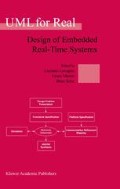Abstract
The ITU service description methodology is widely used to specify the services of telecommunication systems and the equipment providing these services. Separate languages, such as SDL, MSC, or ASN. 1 have traditionally been used to express specifications at the various stages of this methodology. Motivated by the ongoing convergence between telecommunications and computing and the increasing popularity of UML, these languages have been described as UML profiles. In this chapter, we show how the UML can be leveraged as the notation to capture specifications for network services and elements.
Access this chapter
Tax calculation will be finalised at checkout
Purchases are for personal use only
Preview
Unable to display preview. Download preview PDF.
References
International Telecommunications Union, Method for the Characterization of Telecommunication Services supported by an ISDN and Network Capabilities of an ISDN, Recommendation I.130, 1988
International Telecommunications Union, Attribute Technique for the Characterization of Telecommunication Services supported by an ISDN and Network Capabilities of an ISDN, Recommendation I.140, 1988.
International Telecommunications Union, The unified functional methodology for the characterization of services and network capabilities, Recommendation Q.65, 2000.
International Telecommunications Union, Specification and Description Language (SDL), Recommendation Z.100, 2002.
J. Ellsberger, D. Hogrefe, and A. Sarma, SDL, Prentice Hall, Hemel Hempstead, 1997.
A. Olsen, O. Færgemand, B. Møller-Pedersen, R. Reed, and J.R.W. Smith, Systems Engineering Using SDL-92, North-Holland, Amsterdam, 1994.
International Telecommunications Union, Message sequence charts (MSC), Recommendation Z.120, 1999.
International Telecommunications Union, SDL combined with ASN.1 modules (SDL/ASN.1), Recommendation Z.105, 2001.
R. Reed (ed.), Specification and Programming Environment for Communication Software, North Holland, Amsterdam, 1993.
M. Dauphin, G. Fonade, and R. Reed, “SPECS: Making Formal Techniques Usable”, IEEE Software, Vol. 11, 1993.
International Telecommunications Union, SDL+ methodology: Use of MSC and SDL (withASN.1), Recommendation Z.100, Supplement 1, 1997.
J. Rumbaugh, M. Blaha, W. Premerlani, F. Eddy, and W. Lorenson, Object-Oriented Modeling and Design, Prentice Hall, 1992.
Object Management Group, Model Driven Architecture, ORMSC/01-06-01, 2001.
D. Frankel, Model Driven Architecture, Wiley, 2003.
Object Management Group, OMG Unified Modeling Language Specification, 1.4, 1997.
B. Møller-Pedersen and T. Weigert, “Towards a Convergence of SDL and UML”, Proc. 2nd Intl. Conf. on the Unified Modeling Language, Ft. Collins, 1999.
International Telecommunications Union, Call Waiting (CW) Supplementary Service, Recommendation I253.1, 1990.
International Telecommunications Union, Stage 2 Description for Call Completion Supplementary Services Section 1-Call Waiting (CW), Recommendation Q.83.1, 1991.
International Telecommunications Union, ISDN Circuit Mode Switched Bearer Service, Recommendation I.71, 1993.
International Telecommunications Union, Principles of telecommunication services supported by an ISDN and the means to describe them, Recommendation I.210, 1993.
A. Letichevsky and D. Gilbert, “A Model for Interaction of Agents and Environments”, In D. Bert, C. Choppy, and P. Moses (Eds), Recent Trends in Algebraic Development Techniques, Lecture Notes in Computer Science 1827, Springer, 1999, pp. 311–328.
Author information
Authors and Affiliations
Editor information
Editors and Affiliations
Rights and permissions
Copyright information
© 2003 Kluwer Academic Publishers
About this chapter
Cite this chapter
Weigert, T., Reed, R. (2003). Specifying Telecommunications Systems with UML. In: Lavagno, L., Martin, G., Selic, B. (eds) UML for Real. Springer, Boston, MA. https://doi.org/10.1007/0-306-48738-1_14
Download citation
DOI: https://doi.org/10.1007/0-306-48738-1_14
Publisher Name: Springer, Boston, MA
Print ISBN: 978-1-4020-7501-8
Online ISBN: 978-0-306-48738-5
eBook Packages: Springer Book Archive

